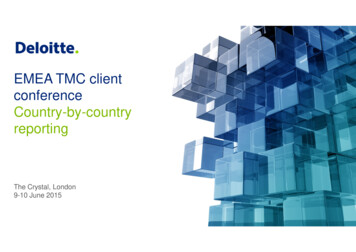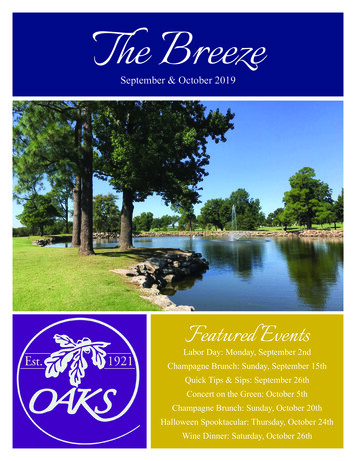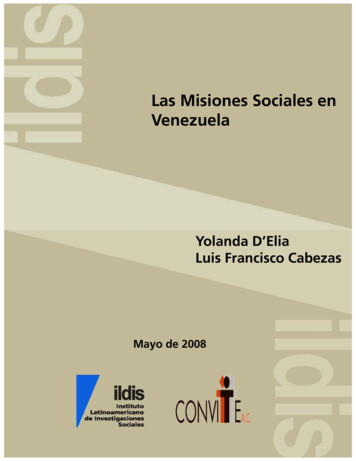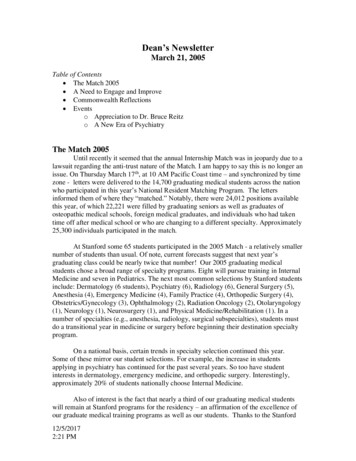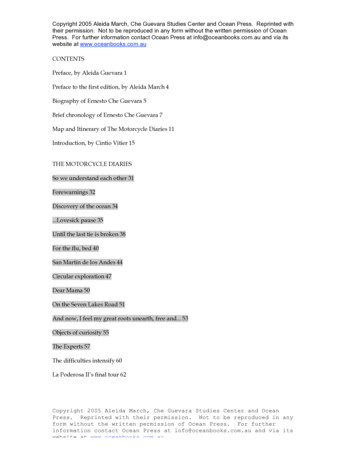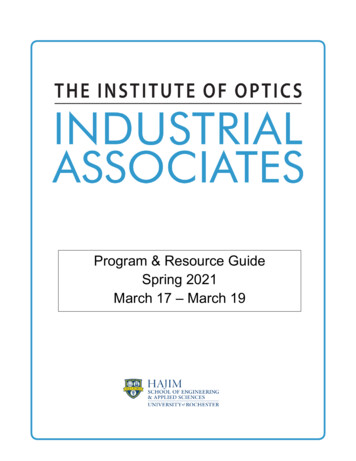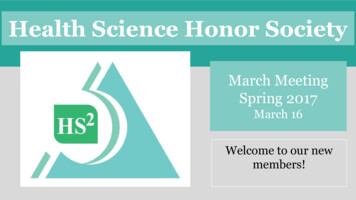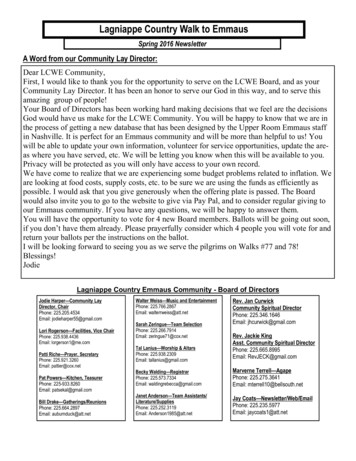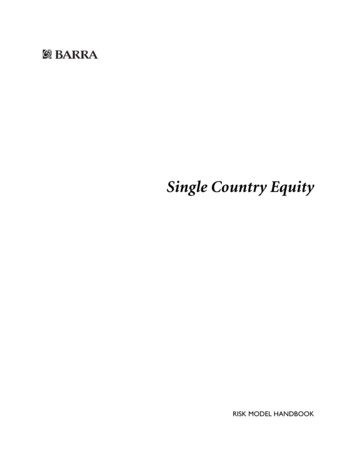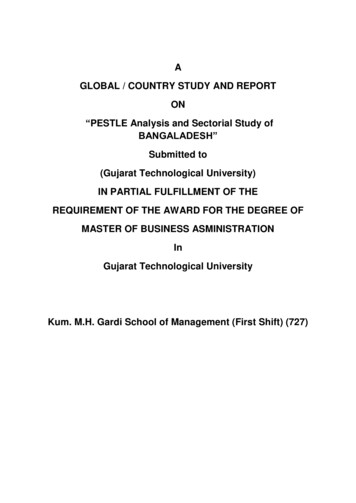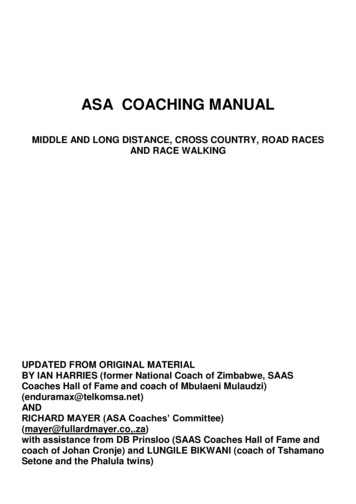
Transcription
Library of Congress – Federal Research DivisionCountry Profile: Venezuela, March 2005COUNTRY PROFILE: VENEZUELAMarch 2005COUNTRYFormal Name: The constitution of December 15, 1999, changedthe name of the country from the Republic of Venezuela(República de Venezuela) to the Bolivarian Republic of Venezuela(República Bolivariana de Venezuela).Short Form: Venezuela.Click to Enlarge ImageTerm for Citizen(s): Venezuelan(s).Capital: Caracas.Major Cities: Caracas, 1.8 million inhabitants; Zulia, 2.9 million; and Carabolo, 1.9 million(2003).Independence: July 5, 1811, from Spain.Public Holidays: Año Nuevo (New Year’s Day), January 1; Carnaval (Carnival), the Mondayand Tuesday before Ash Wednesday, movable dates in early February to early March; Día deSan José (St. Joseph’s Day), March 19; Jueves Santo (Holy Thursday) and Viernes Santo (HolyFriday), movable holidays in March or April; Signing of Independence, April 19; Primero deMayo (Labor Day), May 1; Ascension, May 20;* Corpus Christi, June 10;* Sagrado Corazón(Sacred Heart), June 18;* Battle of Carabobo, June 24; San Pedro y San Pablo (Saint Peter andSaint Paul), June 29;* Firma Acta de Independencia (Signed Act of Independence), July 5; Battleof Boyacá, August 7; Bolívar’s birthday and Battle of Lago de Maracaibo, July 24; La Asunción(Assumption), August 15;* Civil Servants’ Day, September 4; Día de la Raza (Columbus Day),October 12; Todos Santos (All Saints’ Day), November 1;* Independence of Cartagena City,November 11;* La Inmaculada Concepción (Immaculate Conception), December 8; and Navidad(Christmas Day), December 25. Note: * Movable holidays; when they do not fall on a Monday,these holidays are observed the following Monday.Flag:Three equal horizontal bands of yellow, blue, and red, with the coat of armson the hoist side of the yellow band and an arc of seven white, five-pointedstars centered in the blue band.1Click to Enlarge Image
Library of Congress – Federal Research DivisionCountry Profile: Venezuela, March 2005HISTORICAL BACKGROUNDEarly History: On his third voyage to the New World in 1498, Christopher Columbusdiscovered Venezuela, which Alonso de Ojeda and Amerigo Vespucci explored the next year.The early explorers named the country “Venezuela” (Spanish for little Venice) because theyfound inhabitants living in stilt houses in lakes. Venezuela’s original inhabitants were the Cariband Arawak Amerindian peoples. Spanish explorers founded the settlements of Valencia in 1555and Santiago de León de Caracas in 1567. Colonial Venezuela's primary value to Spain wasgeographic. During its annual journey between Portobelo, in present-day Panama, and Cuba, theSpanish bullion fleet depended on Venezuela’s long Caribbean coastline for security fromforeign enemies and pirates. For the first two and a half centuries of colonial rule, Venezuelalacked political unity, in part because it was of no economic importance to Spanish officials.By the late sixteenth century, agriculture had become Venezuela’s chief economic activity. Thecolonial economy became centralized around the city of Caracas as a result of developmentssuch as the growth of the cocoa trade, the Spanish crown’s granting in 1728 of exclusive tradingrights in Venezuela to the Basque-run Caracas Company, and Spain’s suppression of the 1749revolt. In recognition of this growth, Caracas was given political-military authority as the seat ofthe Captaincy General of Venezuela in 1777, marking the first instance of recognition ofVenezuela as a political entity. Nine years later, its designation was changed to the Audiencia deVenezuela, thus granting Venezuela judicial and administrative authority as well.Independence: Periods of political instability, dictatorial rule, and revolutionary turbulencecharacterized much of Venezuela’s nineteenth-century history. In the first decade, after almostthree centuries on the periphery of the Spanish American empire, Venezuela found itself at thecenter of the independence movement sweeping Latin America. Led initially by Francisco deMiranda, the best known of the precursors of the Spanish American revolution, the colonyrebelled against Spain in 1810. However, the rebellion collapsed as a result of a combination offactors, including local and personal rivalries encountered by Miranda; an earthquake that almostcompletely destroyed Caracas and other key cities on March 26, 1812; and Miranda’s subsequentarrest and death in a Spanish jail. Simón Bolívar Palacios, Venezuela’s national hero, native son,and later president, assumed leadership of the struggle for independence. After his victory atCarabobo, Bolívar made a triumphal entry into Caracas in June 1821. Venezuela joined withwhat are now Colombia, Panama, and Ecuador to form the short-lived República de GranColombia (Republic of Greater Colombia), but withdrew in 1830 and became a sovereign state.Caudillo Rule: After Bolívar’s death in December 1830, civilian and military leaders called forthe restoration of legitimate authority. The century of the caudillo (or caudillismo, the system ofrule by a strongman who exercises dictatorial powers), featuring a series of changes in powerfrom one commander to another, started auspiciously with 16 relatively peaceful and prosperousyears under the authority of General Juan Aguerrevere (José Antonio) Páez (president, 1830–31,1837, 1838–43, 1846–47, 1861–63) and several other caudillos. Regarded as second only toBolívar as a national hero, Páez was twice elected president under the 1830 constitution. Amestizo, he established the pattern of dictatorial rule, ruling with the support of the criollo eliteas long as coffee prices remained high. In the 1840s, coffee prices plunged, and the elite dividedinto two factions: those who remained with Páez called themselves Conservatives, and his rivalscalled themselves Liberals. Between 1858 and 1863, local caudillos engaged in a chaotic power2
Library of Congress – Federal Research DivisionCountry Profile: Venezuela, March 2005struggle known as the Federal War because the Liberals favored federalism. In 1870 AntonioGuzmán Blanco (president, 1870–77, 1879–84, 1886–87) finally restored central governmentauthority and ruled for 18 years.For most of the first half of the twentieth century, until 1958, a series of military dictators whopromoted the oil industry and allowed for some social reforms ruled Venezuela. During theregime of General Juan Vicente Gómez (president, 1908–10, 1922–29, 1931–35), oil wasdiscovered in the Maracaibo Basin, and Venezuela changed from a poor, largely agrarian countryinto one of the richest nations in Latin America. A military coup led by General Marcos PérezJiménez (president, 1952–58) overthrew President Rómulo Gallegos Freire, Venezuela's firstdemocratically elected president, on November 24, 1948, after only 10 months in office, ending abrief three-year experiment in democracy known as the trienio, or triennium (1945–48).The Restoration of Democracy: In 1958 a coalition of political groups ousted Pérez Jiménezand restored democracy. Historians have often pointed to the second inauguration of RómuloBetancourt (president, 1945–48, 1959–64) as the pivotal point in four centuries of Venezuelanhistory. After nearly a century and a half as perhaps the most extreme example of LatinAmerica's post-independence affliction of caudillismo and military rule, the event, augmentedwith the adoption of a new constitution in 1961, clearly marked a new era for the country.Venezuela's political life since 1959 has been defined by uninterrupted civilian constitutionalrule. After becoming the first president to have served a full term of office, Betancourt wassucceeded in 1964 by Raúl Leoni (president, 1964–69) and in 1969 by Rafael Caldera Rodríguez(president, 1969–74). Caldera Rodríguez did much to create economic and political stability,although the latter was marred by terrorist abductions and assassinations. Stability increased in1974, after the election of Carlos Andrés Pérez (president, 1974–79, 1989–93) of the DemocraticAction Party (Acción Democrática—AD). However, Pérez’s first term coincided with a fourfoldrise in oil prices in late 1973, and by 1979 the Venezuelan economy had stalled and corruptionwas widespread. At the end of 1989, the so-called Caracazo riots, in which more than 200 peoplewere killed, was a response to an economic austerity program launched by then-President Pérez.In February 1992, a group of army lieutenant colonels led by Lieutenant Colonel Hugo ChávezFrías, an outspoken paratroop commander, mounted an unsuccessful coup attempt, claiming thatthe events of 1989 showed that the political system no longer served the interests of the people.A year later, Congress impeached Pérez on corruption charges. In 1994 public disaffection withthe political system compelled President Rafael Caldera (president, 1969–74, 1994–98) topardon Chávez, who had attained folk-hero status while in prison.The Chávez Presidency: Until the elections of December 1998, the president had always been arepresentative of one of the two so-called traditional parties—the AD, which is socialdemocratic; and the Social Christian Party (Comité de Organización Política ElectoralIndependiente—COPEI), which is Christian Democratic. However, by 1998 the AD and COPEIhad become largely discredited because of their association with corrupt and inept governments.Exploiting the popular desire for new leadership, Chávez ran for president in the December 1998elections as the candidate of Patriotic Pole (Polo Patriótico—PP), an alliance of his own FifthRepublic Movement (Movimiento Quinta República—MVR) and two other leftist parties,Homeland for All (Patria Para Todos—PPT) and Movement Toward Socialism (Movimiento alSocialismo—MAS). He won a landslide victory, garnering more votes than any candidate in3
Library of Congress – Federal Research DivisionCountry Profile: Venezuela, March 2005Venezuela’s history. Part of his program of radical change was a complete rewriting of the 1961constitution by a specially elected Constituent Assembly, as approved by a referendum held inApril 1999. In a national referendum held in December 1999, 72 percent of the populationratified the new constitution. On July 30, 2000, Chávez was reelected president with 60 percentof the vote for a six-year term.In 2001 many middle-class Venezuelans became disenchanted with the Chávez government’sfailure to deliver on promises to improve personal security, create jobs, and generate economicgrowth. Chávez’s flouting of constitutional procedures in favor of cronyism alienated manyVenezuelans, including some top military officers who viewed his politically motivated, highlevel military promotions as a replacement of professionalism with cronyism. A broad-basedopposition front, the Democratic Coordinator (Coordinadora Democrática—CD), with thesupport of the conservative business chambers, unions, and Venezuelan Petroleum, staged twonational strikes in 2002–3. In the first antigovernment protest in March 2002, the military brieflydeposed Chávez, but loyal army elements restored him to the presidency two days later.Moreover, the opposition failed to oust Chávez in a national referendum on August 15, 2004.Judged by outside observers as a free and fair vote, the referendum confirmed Chávez’s rule untilJanuary 2007, when his presidential mandate is scheduled to end. In the absence of a morepopular challenger, however, Chávez could be reelected to a second six-year term.GEOGRAPHYLocation: Located in northern South America, Venezuela is borderedto the north by the Caribbean Sea and the North Atlantic Ocean, to theeast by Guyana, to the south by Brazil, and to the west by Colombia.Size: Venezuela has a total area of 912,050 square kilometers (land:882,050 square kilometers; water: 30,000 square kilometers), or morethan twice the size of California.Click to Enlarge ImageLand Boundaries: Venezuela’s borders total 4,993 kilometers, of which 2,200 kilometers adjoinBrazil; 2,050 kilometers, Colombia; and 743 kilometers, Guyana.Disputed Territory: Venezuela has territorial disputes with both its western and eastern SouthAmerican neighbors. Colombia and Venezuela dispute substantial maritime territory lying off theGuajira Peninsula and in the Golfo de Venezuela (Gulf of Venezuela). Although this dispute isbeing resolved through bilateral negotiations, elements of national prestige have made it anational issue in both countries in recent decades. Venezuela claims two-thirds of Guyana, or allof the 146,000-square-kilometer area lying west of the Essequibo, Guyana’s longest river, whichruns north to the Atlantic Ocean and provides a natural dividing line through the small, Englishspeaking enclave. This claim precludes any discussion of a maritime boundary with Guyana. InOctober 1999, in response to Guyana’s granting of oil and mineral contracts to foreigncompanies to operate in the Essequibo region, Venezuela’s legislature voided the 1899 Tribunalof Arbitration Treaty that determined boundaries between the two countries.4
Library of Congress – Federal Research DivisionCountry Profile: Venezuela, March 2005Venezuela also has a territorial dispute with Dominica and its Eastern Caribbean neighbors—Saint Kitts and Nevis, Saint Lucia, and Saint Vincent and the Grenadines—over Aves (Bird)Island, which is located 568 kilometers north of Venezuela and 113 kilometers west ofDominica. France, the Netherlands, and the United States recognize Venezuela’s claim that the0.35-square-kilometer isle sustains human habitation and therefore creates a Venezuelanexclusive economic zone/continental shelf extending over a large portion of the Caribbean Sea.Length of Coastline: Venezuela’s coastline totals 2,800 kilometers.Maritime Claims: Venezuela claims a 200-nautical mile exclusive economic zone, a 12-nauticalmile territorial sea, a 15-nautical mile contiguous zone, and jurisdiction over the continental shelfto a 200-meter depth or to th
Independiente—COPEI), which is Christian Democratic. However, by 1998 the AD and COPEI had become largely discredited because of their association with corrupt and inept governments. Exploiting the popular desire for new leadership, Chávez ran for president in the December 1998 elections as the candidate of Patriotic Pole (Polo Patriótico—PP), an alliance of his own Fifth Republic .
